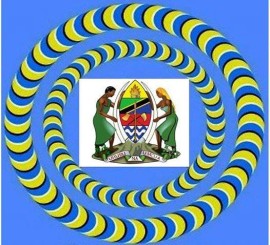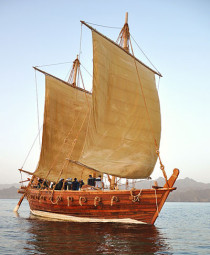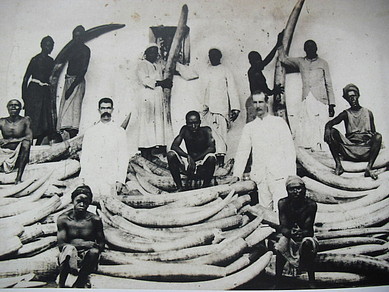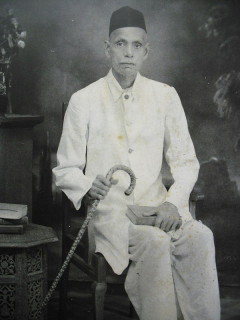During colonial times, Indians were taken into different parts of the world as slaves by the British East India Company,[9] and the British Empire.[10] Over a million indentured labourers also called girmitiyas from Uttar Pradesh and Bihar were taken as slave labourers to European colonies of British and Dutch in Fiji, South Africa, and Trinidad & Tobago.[11][12] The Portuguese imported Africans into their Indian colonies on the Konkan coast between about 1530 and 1740..
African Diaspora in the Indian Ocean World
http://exhibitions.nypl.org/africansindianocean/essay-south-asia.php
In 1490, an African guard, Sidi Badr, seized power in Bengal and ruled for three years before being murdered. Five thousand of the 30,000 men in his army were Ethiopians. After Sidi Badr’s assassination, high-level Africans were driven out and migrated to Gujarat and the Deccan.
http://originalpeople.org/africans-india-slaves-generals-rulers-exhibit-schomburg-center-research-black-culture-2/
Dr Abdulaziz Y. Lodhi
Oct 29, 2008
In his work on the Sidis of India, Abdulaziz Y. Lodhi discusses the historical experiences of a group of prominent East African ancestry in the Indian sub-continent. Exploring linguistic developments and the role of Islam in their broader integration, the author discusses the new championing of the Swahili language of a group keen to revitalise their cultural links to Africa and reconstruct their heritage. With the group gaining wider scholarly and public recognition in recent years, Lodhi also reflects on Bantu linguistic data observable in contemporary Sidi speech and the effect of new efforts at cultural revival spearheaded by touring Sidi musical performers.
http://www.pambazuka.org/global-south/bantu-origins-sidis-india
4 African Kings Who Ruled India That Have Been Erased From History
“Ethiopians have had very intimate relations with Indians. In fact, in antiquity the Ethiopians ruled much of India. These Ethiopians were called the Naga. It was the Naga who created Sanskrit. A
reading of ancient Dravidian literature which dates back to 500 BC, gives us considerable information on the Naga. In Indian tradition the Naga won central India from the Villavar (bowmen) and
Minavar (fishermen).”
https://www.panafricanalliance.com/african-kings-india/
The Siddi
The Siddi (Urdu: شیدی ; Kannada: ಸಿದ್ಧಿಗಳು; Hindi, Marathi, Konkani: सिद्दी or शीदि/ಸಿದ್ಧಿ; Sindhi: شيدي; Gujarati: સીદી), also known as Siddhi, Sheedi, Habshi or Makrani, are an ethnic group inhabiting India and Pakistan. Members are descended from Bantu peoples from Southeast Africa that were brought to the Indian subcontinent as slaves by Arab and Portuguese merchants.[1] The Siddi community is currently estimated at around 20,000–55,000 individuals, with Karnataka, Gujarat and Hyderabad in India and Makran and Karachi in Pakistan as the main population centres.[2] Siddis are primarily Sufi Muslims, although some are Hindus and others Roman Catholic Christians.[3]
http://en.wikipedia.org/wiki/Siddi
http://en.wikipedia.org/wiki/Siddis_of_Karnataka
http://exhibitions.nypl.org/africansindianocean/essay-south-asia.php
"Drumming and Praying" by Helene Basu
Sidis and their Music: African Culture in India
http://d-nb.info/101656516X/34
Ḥabshī, African and Abyssinian slaves in pre-British India. The name derives from the Arabic word Ḥabashī (“Abyssinian”), through its Persian form. Such slaves, frequently employed by the chiefs of Muslim India, especially in the Deccan, were believed to have great physical prowess and ability and a lack of personal ties, which promoted loyalty.
Many Ḥabshī rose to high office and some became independent. The most famous of them was Malik ʿAmbar of Ahmadnagar, who defied the Mughals for many years. Ḥabshī in western India, the Sidis of Janjira, commanded the fleet of the Bijapur sultan and became independent chiefs. They defied the Marathas and in 1670 transferred their allegiance to the Mughal emperor Aurangzeb. They accepted British supremacy and maintained their state until 1948, when it was integrated with the Bombay state of the new Indian union.
The Sidi Project
African Rulers of India
When black was no bar, how Africans shaped Indian History.
African rulers of India: That part of our history we choose to
forget
https://indianexpress.com/article/research/african-rulers-of-india-that-part-of-our-history-we-choose-to-forget/?fbclid=IwAR0-2_KfXt8jU3nvQ86XN7bsqgX0qzQFvfhUUbmjo3MR_Ck3pSWy1hY-hm4
African rulers of India: That part of our history we choose to forget - See more at:
Malik Ambar (1549 – 13 May 1626) was an Ethiopian born in Harar, who played a significant military role in the Deccan region of India.
Sold as a child by his parents, Malik was brought to India as a slave. In time he created an independent army, a mercenary force numbering up to 1500 men. It was based in the Deccan region and was hired by local kings.
Rare images document the centuries-long history of Africans in India
http://scroll.in/article/682635/Rare-images-document-the-centuries-long-history-of-Africans-in-India
African Muslim Elites In India
http://moorishharem.com/african-muslim-elites-in-india/
Africans in India: From Slaves to Generals and Rulers (Exhibit by Schomburg Center for Research in Black Culture)
http://www.bbc.co.uk/news/world-asia-india-30391686
http://www.nypl.org/blog/2013/01/31/africans-india-slaves-generals-and-rulers
http://www.sylvianediouf.com/africans_in_india__from_slaves_to_generals_and_rulers_119627.htm
https://face2faceafrica.com/article/africans-in-india#.VQgFLstybtR
http://thewire.in/2016/03/20/africans-in-india-pictures-that-speak-of-a-forgotten-history-25347/
The Sidi Saiyyed Mosque, popularly known as Sidi Saiyyid ni Jali locally, built in 1572-73 AD (Hijri year 980), is one of the most famous mosques of Ahmedabad, Gujarat, India. As attested by the marble tablet fixed on the wall of the mosque, it was built by Sidi Saiyyid in the retinue of Bilal Jhajar Khan, general in the army of the last Sultan Shams-ud-Din Muzaffar Shah III of the Gujarat Sultanate.
https://www.revolvy.com/page/Sidi-Saiyyed-Mosque
AFRICANS IN INDIA
Makrani Culture
In Pakistan the Makrani people are mostly found in Balochistan in the Makran Coast and in lower Sindh mainly in the Lyari area which comes under Karachi. The Makrani people are also known as Sheedis because of their physical appearance.
http://historypak.com/makrani-culture/
Sheedis of Pakistan: Living To The African Rhythm.
While the greatly fascinating ‘Macedonian’ Tribe, the Kalash of Pakistan, are relatively well-known and heard of, not many are familiar with the ’Sheedi’ people or the indigenous Africans of Pakistan.
http://hafsakhawaja.wordpress.com/2012/01/13/sheedis-of-pakistan-living-to-the-african-rhythm/
The Sri Lankan Kaffirs
The Sri Lankan Kaffirs (cafrinhas in Portuguese, කාපිරි kāpiriyō in Sinhala, and காப்பிலி kāpili in Tamil) are an ethnic group in Sri Lanka who are partially descended from 16th century Portuguese traders and Bantu slaves who were brought by them to work as labourers and soldiers to fight against the Sinhala Kings.[2][3] They are very similar to the Zanj-descended populations in Iraq and Kuwait, and are known in Pakistan as Sheedis and in India as Siddis.[2] The Kaffirs spoke a distinctive creole based on Portuguese, the Sri Lanka Kaffir language, now extinct. Their cultural heritage includes the dance styles Kaffringna and Manja and their popular form of dance music Baila.
http://en.wikipedia.org/wiki/Sri_Lanka_Kaffirs
http://en.wikipedia.org/wiki/Africans_in_Sri_Lanka



































